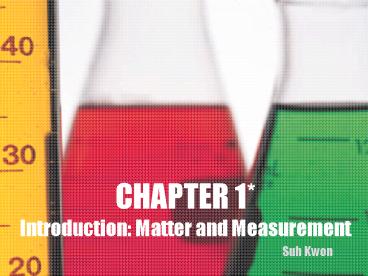CHAPTER 1* Introduction: Matter and Measurement PowerPoint PPT Presentation
1 / 12
Title: CHAPTER 1* Introduction: Matter and Measurement
1
CHAPTER 1Introduction Matter and Measurement
- Suh Kwon
2
1.1 The Study of Chemistry
- The Molecular Perspective of Chemistry
- Matter physical material of the universe that
has mass and occupies space - Element substance that cannot be separated into
simpler substances by chemical means - Atom almost infinitesimally small building
blocks of matter - Molecules chemical combination of two ore more
atoms
3
1.2 Classifications of Matter
- States of Matter
Solid Liquid Gas
Both a definite shape and a definite volume Distinct volume independent of its container but has no specific shape No fixed volume or shape conforms to the volume or shape of its container
Rigid Assumes the shape of the portion of the container that it occupies Can compress or expand to occupy a smaller or larger volume
Molecules are held tightly together, usually in definite arrangement wiggling only slightly Molecules are packed more closely together, but still move rapidly allowing them to slide over each other Molecules are far apart and are moving at high speeds, colliding repeatedly with each other
4
- Pure Substances and Mixtures
- Pure Substance (referred to as a substance)
matter that has a fixed composition and distinct
properties - Classified as either ..
- Elements (composed of only one kind of atom)
- Compounds (composed of two ore more elements)
- Mixture combinations of two or more substances
in which each substance retains its own chemical
identity and its own properties compositions
vary - Heterogeneous do not have the same composition,
properties, and appearance throughout the
mixtures (Ex sand, rocks, and wood) - Homogeneous uniform throughout the
mixtures(Ex air, such as nitrogen, oxygen, etc)
5
- Separation of Mixtures
- Filtration (for heterogeneous mixtures)
- Ex to separate iron filings from gold ones, use
a magnet to attract the iron - Distillation (for homogeneous mixtures)
- Ex to separate salt from water, boil the
solution thus, water will evaporate while the
salt is left behind because water has a much
lower boiling point than table salt - Chromatography ?
https//www.crimescene.com/store/bmz_cache/b/b3ac1
0ad9721f4d3399d6f4b82111806.image.220x223.jpg
6
1.3 Properties of Matter
- Physical properties w/o changing identity and
composition (color, odor, density, melting
point, boiling point, and hardness) - Ex When water evaporates, it changes from liquid
to gas however, its composition does not change
it is still water - Chemical properties substance that may change
or react to form other substances - Ex Flammability, which is the ability to burn a
substance in the presence of oxygen, transforms
one substance into a chemically different one - Intensive properties does not depend on the
amount of the sample being examined
(temperature, melting point, and density) - Extensive properties depend on the quantity and
amount of the sample (measurements of mass and
volume)
7
1.4 Units of Measurement
- SI Units
Physical Quantity Name of Unit Abbreviation
Mass Kilogram kg
Length Meter m
Time Second sa
Electric current Ampere A
Temperature Kelvin K
Luminous intensity Candela cd
Amount of substance Mole mol
8
- Derived SI Units
- Density mass
- volume
- ? Practice Problem!!
- Calculate the density of mercury if 1.00 x 102
g occupies a volume of 7.36 cm3. - (Answer)
- Density mass 1.00 x 102 g 13.6 g/cm3
- volume 7.36 cm3
9
1.5 Uncertainty in Measurement
- Precision and Accuracy
- Precision a measure of how closely individual
measurements agree with one another - Accuracy how closely individual measurements
agree with the correct, or true value
http//celebrating200years.noaa.gov/magazine/tct/a
ccuracy_vs_precision_556.jpg
10
- Significant Figures
- Guidelines to determine the number of sig.
figures - Nonzero digits are always significant
- (214 THREE significant figures)
- Zeros between nonzero digits are always
significant - (1004 FOUR significant figures)
- Zeros at the beginning of a number are never
significant - (0.01 ONE significant figure)
- Zeros that fall both at the end of a number and
after the decimal point are always significant - (4.0 TWO significant figures)
11
- Significant Figures in Calculations
- Multiplication and Division the result must be
reported with the same number of significant
figures as the measurement with the fewest
significant figures - Addition and Subtraction the result cannot have
more digits to the right of the decimal point
than any of the original numbers
12
1.6 Dimensional Analysis
- Conversion factor
- given unit x desired unit desired unit
- given unit
- ? Example
- Converting 8.00 meters to inches
- 8.00 m x 100 cm x 1 in. 315 inches
- 1 m 2.54 cm

